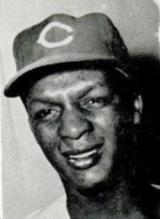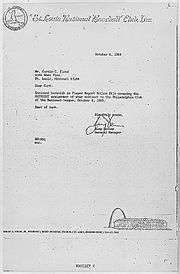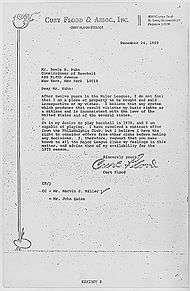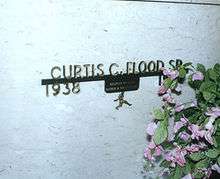Curt Flood
Curtis Charles Flood (January 18, 1938 – January 20, 1997) was an American baseball player. He was a center fielder who played 15 seasons in the major leagues for the Cincinnati Redlegs, St. Louis Cardinals, and Washington Senators. Flood was a three-time All-Star, a Gold Glove winner for seven consecutive seasons, and batted over .300 in six seasons.[1] He led the National League (NL) in hits (211) in 1964 and in singles, 1963, 1964, and 1968. Flood also led the National League in putouts as center fielder four times and in fielding percentage as center fielder three times. He retired with the third most games in center field (1683) in NL history, trailing Willie Mays and Richie Ashburn.
| Curt Flood | |||
|---|---|---|---|
Flood with the Cardinals | |||
| Center fielder | |||
| Born: January 18, 1938 Houston, Texas | |||
| Died: January 20, 1997 (aged 59) Los Angeles, California | |||
| |||
| MLB debut | |||
| September 9, 1956, for the Cincinnati Redlegs | |||
| Last MLB appearance | |||
| April 25, 1971, for the Washington Senators | |||
| MLB statistics | |||
| Batting average | .293 | ||
| Home runs | 85 | ||
| Runs batted in | 636 | ||
| Teams | |||
| Career highlights and awards | |||
| |||
Flood became one of the pivotal figures in the sport's labor history when he refused to accept a trade following the 1969 season, ultimately appealing his case to the U.S. Supreme Court.[2] Although his legal challenge was unsuccessful, it brought about additional solidarity among players as they fought against baseball's reserve clause and sought free agency.
Early years
Born in Houston, Texas, and raised in Oakland, California,[3] Flood played in the same outfield in West Oakland's McClymonds High School as Vada Pinson and Frank Robinson. All three would eventually sign professional contracts with the Cincinnati Reds.[4] Flood attended McClymonds High School and transferred to Oakland Technical High School, where he graduated.
MLB career
Flood signed with the Cincinnati Reds in 1956 and made a handful of appearances for the team in 1956–57. But with future star centerfielder Vada Pinson preparing to be promoted to the majors, Flood was deemed expendable. He was traded to the St. Louis Cardinals in December 1957.[5] For the next 12 seasons, he became a fixture in center field for St. Louis; although he struggled at the plate from 1958 to 1960, his defensive skill was apparent. He had his breakthrough year at the plate after Johnny Keane took over as manager in 1961: he batted .322, followed by .296 in 1962 with 11 home runs. He continued to improve offensively in 1963, hitting .302 and scoring a career-high 112 runs, third most in the NL; he also had career bests in doubles (34), triples (9) and stolen bases (17) and collected 200 hits in an NL-leading 662 at bats. In that year he received the first of his seven consecutive Gold Gloves.[6]

He earned his first All-Star selection in 1964. He batted .311. His 679 at-bats led the NL again and were the fifth highest total in league history to that point, setting a team record by surpassing Taylor Douthit's 1930 total of 664; Lou Brock broke the team record three years later with 689. He tied for tops in hits with The Pittsburgh Pirates' Roberto Clemente with 211.[7] Batting leadoff in the World Series against the New York Yankees, he hit only .200 but scored in three of the Cardinal victories as the team won in seven games for its first championship since 1946. In 1965, Flood had his greatest power output with 11 home runs and 83 runs batted in while he was hitting .310. He made the All-Star team again in 1966, a season in which he did not commit a single error in the outfield; his record errorless streak of 226 games (NL record for an outfielder[RetroSimba 1]) and 568 total chances (major league record) ran from September 3, 1965, to June 4, 1967.
In 1967 he had his highest batting mark with a .335 average (though his other batting totals fell off from previous years), helping the Cardinals to another championship. In the World Series against the Boston Red Sox he hit a woeful .179 but made some crucial contributions. In game 1, he advanced Brock to third base twice, putting him in position to score both runs in a 2–1 victory; in game 3, he drove Brock in with the first run of a 5–2 win. As team co-captain (with Tim McCarver) in 1968 he had perhaps his best year, earning his third All-Star selection and finishing fourth in the MVP balloting (won by teammate Bob Gibson) on the strength of a .301 batting average and 186 base hits. Against the San Francisco Giants that year, Flood was involved in the final outs of the first back-to-back no-hitters in major league history. On September 17, he struck out for the final out of Gaylord Perry's 1–0 gem. The next day, he caught Willie McCovey's fly ball for the final out of Ray Washburn's 2–0 no-hitter.[8][9] Had he not momentarily lost his footing chasing a Jim Northrup fly ball (ruled a triple) with two out in the seventh inning of game 7 of the World Series against the Detroit Tigers, the Cardinals might have won their third championship of the decade; Detroit scored twice on the play, with Northrup later coming in for a 3–0 lead, and won the game, 4–1. Up to that point, Flood had been enjoying the best series of his career despite dealing with personal problems at home,[10] hitting .286 with three steals.
After the season ended, Flood was upset when Cardinals' president Gussie Busch, also CEO of team owner Anheuser-Busch, offered him only a $5,000 raise, far short of the $90,000 salary he believed he deserved after his stellar regular season. He believed Busch, with whom he had hitherto enjoyed a close personal friendship, was expressing his displeasure over the error that had likely cost the team the Series. While Busch eventually relented, Flood took it personally when Busch publicly chewed the team out after most players boycotted spring training before the 1969 season for a week, accusing players of forgetting that fans were what kept the sport going (although he did not mention any player by name).[11]
In 1969, despite the lower pitching mound instituted that season, which saw a general rise in batting average league-wide, Flood's batting average slipped to .285. His brother was arrested during the season.[10] Late in the season, he publicly criticized the team for reorganizing the team before they were officially eliminated. He received his seventh Gold Glove that season just as other events in his career began to affect the entire sport. Flood collected the first hit in a major league regular season game in Canada. He doubled off Montreal Expos pitcher Larry Jaster in the first inning of the Expos' inaugural home game on April 14 at Jarry Park. (Jaster, a Cardinal teammate of Flood's the year before, had been selected by the Expos in the expansion draft.)
Challenge of the reserve clause


Despite his outstanding playing career, Flood's principal legacy developed off the field. He believed that Major League Baseball's decades-old reserve clause was unfair in that it kept players beholden for life to the team with which they originally signed, even when they had satisfied the terms and conditions of those contracts.
On October 7, 1969, the Cardinals traded Flood, Tim McCarver, Byron Browne, and Joe Hoerner to the Philadelphia Phillies for Dick Allen, Cookie Rojas, and Jerry Johnson. Flood refused to report to the moribund Phillies, citing the team's poor record and dilapidated Connie Mack Stadium, and for (what he thought were) belligerent—and racist—fans. Flood said, "That I didn't think that I was going to report to Philadelphia, mainly because I didn't want to pick up twelve years of my life and move to another city."[12] Some reports say he was also irritated that he had learned of the trade from a reporter;[13] but Flood wrote in his autobiography that he was told by midlevel Cardinals management and was angry that the call did not come from the general manager,[14] further alienating him from Busch.[11] He met with Phillies' general manager John Quinn, who left the meeting believing that he had persuaded Flood to report to the team.[14] Flood stood to forfeit a lucrative $100,000 (equivalent to $658,355 in 2019)[15] contract if he did not report; but after a meeting with players' union head Marvin Miller,[16] who informed him that the union was prepared to fund a lawsuit, he decided to pursue his legal options.[6]
In a letter to Baseball Commissioner Bowie Kuhn, Flood demanded that the commissioner declare him a free agent:
- December 24, 1969
- After twelve years in the major leagues, I do not feel I am a piece of property to be bought and sold irrespective of my wishes. I believe that any system which produces that result violates my basic rights as a citizen and is inconsistent with the laws of the United States and of the several States.
- It is my desire to play baseball in 1970, and I am capable of playing. I have received a contract offer from the Philadelphia club, but I believe I have the right to consider offers from other clubs before making any decision. I, therefore, request that you make known to all Major League clubs my feelings in this matter, and advise them of my availability for the 1970 season.[6][14]
Flood was influenced by the events of the 1960s that took place in the United States. According to Marvin Miller, Flood told the executive board of the players' union, "I think the change in black consciousness in recent years has made me more sensitive to injustice in every area of my life." However, he added that what he was doing in challenging the reserve clause was primarily as a major league ballplayer.[17]
Flood v. Kuhn
Commissioner Kuhn denied Flood's request for free agency, citing the propriety of the reserve clause and its inclusion in Flood's 1969 contract. On January 16, 1970, Flood filed a $1 million lawsuit against Kuhn and Major League Baseball, alleging violation of federal antitrust laws.[18] Even though Flood was making $90,000 at the time,[3] he likened the reserve clause to slavery. Among those testifying on his behalf were former players Jackie Robinson and Hank Greenberg, and former owner Bill Veeck; no active players testified, nor did any attend the trial. Although players' union representatives had voted unanimously to support Flood, rank-and-file players were strongly divided, with many avid supporters of the management position.[6]
Flood v. Kuhn (407 U.S. 258) was argued before the Supreme Court on March 20, 1972.[19][20][21] Flood's attorney, former Supreme Court Justice Arthur Goldberg, asserted that the reserve clause depressed wages and limited players to one team for life. Major League Baseball's counsel countered that Commissioner Kuhn had acted "for the good of the game." On June 19, 1972, the Supreme Court, invoking the principle of stare decisis ("to stand by things decided"), ruled 5–3 in favor of Major League Baseball,[22][23][24] citing as precedent a 1922 ruling in Federal Baseball Club v. National League (259 U.S. 200). Justice Lewis Powell recused himself owing to his ownership of stock in Anheuser-Busch, which owned the Cardinals.[6]
Consequences
After Flood's lawsuit lost, many consequences followed. One of the worst things that happened to Flood was being blackballed from baseball following his lawsuit. There were questions similar to “Do you realize you won’t be able to play in MLB ever again?” or “You realize you are going to lose your job?” Everyone Flood consulted was convinced he would be blackballed from baseball. Flood soon came to realization that his career was over as he later said,
It would be difficult to come back. And besides, I don’t think I’ll be getting the opportunity to play again. As big as it is, baseball is a closely-knit unit. I doubt even one of the 24 men controlling the game would touch me with a ten-foot (3 m) pole. You can’t buck the Establishment.[25]
Another outcome of Curt Flood's lawsuit, albeit 26 years later, was the Curt Flood Act of 1998. Gary R. Roberts, a graduate and author in the Marquette Law Scholarly Journal, explains the Act as:
[T]he conduct, acts, practices, or agreements of persons' in the business of organized professional major league baseball directly relating to or affecting employment of major league baseball players to play baseball at the major league level are subject to the antitrust laws to the same extent such conduct, acts, practices, or agreements would be subject to the antitrust laws if engaged in by persons in other professional sports business affecting interstate commerce.[26]
This act did exactly what Flood wanted; it stopped owners from controlling the players’ contracts and careers. Not only did Flood help modify the Reserve Clause, he also helped bring in the 10/5 rule, which is also known as the Curt Flood Rule. The rule states that when a player has played for a team for five straight years, and played in MLB for a total of ten years, they have to give the club their consent to be traded.[27]
Aftermath and post-baseball life
Flood sat out the entire 1970 season.[6] During this period he was bombarded with hate mail from fans, who accused him of trying to destroy baseball; his teammate Bob Gibson estimated "He got four or five death threats a day."[28] The Cardinals sent two minor leaguers to the Phillies in compensation for Flood's refusal to report. One of them—centerfielder Willie Montañez—went on to a 14-year major league career. In November 1970, the Phillies traded Flood and four other players to the Washington Senators. He signed a $110,000 contract with Washington but played only thirteen games of the 1971 season, with a .200 batting average and lackluster play in center field. Despite manager Ted Williams's vote of confidence, Flood left the team in late April and retired.[29][30][31] He had a lifetime batting average of .293 with 1,861 hits, 85 home runs, 851 runs, and 636 RBI. Defensively, Flood posted a .987 fielding percentage in his major-league career.[32] Later that year Flood published a memoir entitled The Way It Is in which he spelled out in detail his argument against the reserve clause.[10] Four years later, in what is now remembered as the Seitz decision, arbitrator Peter Seitz ruled that since pitchers Andy Messersmith and Dave McNally played for one season without a contract, they were entitled to become free agents. The ruling essentially nullified the reserve clause and opened the door to widespread free agency.
After his retirement Flood purchased a bar in the resort town of Palma on the island of Majorca, where he had moved in the wake of bankruptcy of his Curt Flood Associates business, two lawsuits, and an IRS lien on a home he bought for his mother.[10] He returned to baseball as a member of the Oakland Athletics broadcasting team in 1978. In 1988 he was named commissioner of the short-lived Senior Professional Baseball Association.[6] In the mid-1990s he joined the management group of the United Baseball League (UBL), which was envisioned as a smaller alternative to MLB. While the group negotiated a long-term TV contract with Liberty Media, the deal (and the UBL) failed when Liberty was absorbed by MLB contractor Fox Sports.[33] In his spare time, he painted; his 1989 oil portrait of Joe DiMaggio sold at auction for $9,500 in 2006.[34]
Flood's struggle for free agency was featured in Ken Burns' documentary series Baseball in 1994. He was inducted into the Baseball Reliquary's Shrine of the Eternals in 1999.[35]
Personal life and health

Flood was married twice and had five children. His first marriage was to Beverly Collins from 1959 until 1966 and together they had five children; Debbie, Gary, Shelly, Scott, and Curt Flood, Jr. Flood later married actress Judy Pace in 1986, whom he had met and dated previously from 1966 until 1970. They remained married until his death.[36] Diagnosed with throat cancer in 1995, Flood was initially given a 90–95 percent chance of survival. He underwent radiation treatments, chemotherapy, and throat surgery, which left him unable to speak.[37]
Death and legacy
On January 20, 1997, just two days after his 59th birthday, Flood died at UCLA Medical Center in Los Angeles, California, after developing pneumonia,[3][38][39][40] and was interred in Inglewood Park Cemetery in Inglewood.[41]
Just prior to his death, Flood's legacy was acknowledged in Congress in 1997 via the Baseball Fans and Communities Protection Act of 1997.[42] Numbered HR 21 (Flood's Cardinals uniform number) and introduced in the House of Representatives on the first day of the 105th Congress by Rep. John Conyers, Jr. (D–Michigan), the legislation established federal antitrust law protection for major league baseball players to the same extent as provided for other professional athletes. Similar legislation, titled the Curt Flood Act of 1998 and sponsored by Sen. Orrin Hatch (R–Utah), was introduced in the Senate and enacted into law the following year.[43][44] Curt Flood is a nonparticipating but pivotal character in the book Our Gang by Philip Roth.
References
- Leggett, William (August 19, 1968). "Not just a Flood, but a deluge". Sports Illustrated. p. 18.
- Leggett, William (March 23, 1970). "A Bird in hand and a burning Busch". Sports Illustrated. p. 18.
- Durso, Joseph (January 21, 1997). "Curt Flood Is Dead at 59; Outfielder Defied Baseball". The New York Times. Retrieved 2008-02-28.
- "Remembering Vada Pinson". miscbaseball.wordpress.com. Retrieved 1 October 2011.
- Reds get Schmidt in 5-man trade
- Pietrusza, David; Matthew Silverman; Gershman, Michael (2000). Baseball: The Biographical Encyclopedia. New York: Total Sports. pp. 364–366. ISBN 1-892129-34-5.
- "Flood of Free Agency". SPORTSCENTURY BIOGRAPHY. ESPN Classic. Retrieved 27 October 2013.
- Pankin, Mark. "Retrosheet Boxscore: San Francisco Giants 1, St. Louis Cardinals 0". www.retrosheet.org. Retrieved June 6, 2009.
- Pankin, Mark. "Retrosheet Boxscore: St. Louis Cardinals 2, San Francisco Giants 0". www.retrosheet.org. Retrieved June 6, 2009.
- Weiss, Stuart L. (2007). The Curt Flood Story: The Man Behind the Myth. University of Missouri Press. ISBN 978-0-8262-1740-0.
- Knoedelseder, William (2012). Bitter Brew: The Rise and Fall of Anheuser–Busch and America's Kings of Beer. HarperCollins. pp. 109–113. ISBN 978-0-06-200927-2.
- Flynn, Neil. Baseball's Reserve System. Walnut Park Group, Inc.
- Snyder, Brad (2006). A Well-Paid Slave: Curt Flood's Fight for Free Agency in Professional Sports. Viking Adult. p. 472. ISBN 0-670-03794-X.
- Carter, Richard D.; Flood, Curt (1971). The way it is. New York: Trident Press. p. 236. ISBN 0-671-27076-1.
- Federal Reserve Bank of Minneapolis. "Consumer Price Index (estimate) 1800–". Retrieved January 1, 2020.
- Lupien, Tony; Lowenfish, Lee (1980). The imperfect diamond: the story of baseball's reserve system and the men who fought to change it. New York: Stein and Day. pp. 207–221. ISBN 0-8128-2709-0.
- Miller, Marvin; (1991). A Whole Different Ball Game: The Sport and Business of Baseball. New York: Carol Publishing Group. pp. 185-186. ISBN 1-55972-067-0.
- Google Scholar
- "Court hears Flood case arguments". Pittsburgh Press. UPI. March 21, 1972. p. 30.
- "US high court hears Flood case". Milwaukee Sentinel. Associated Press. March 21, 1972. p. 2, part 2.
- "Reserve clause violates Constitution, antitrust laws, Supreme Court told". Toledo Blade. (Ohio). Associated Press. March 21, 1972. p. 29.
- "Baseball wins in high court". Pittsburgh Press. UPI. June 19, 1972. p. 1.
- "Another baseball strike possible". Toledo Blade. (Ohio). Associated Press. June 20, 1972. p. 26.
- "Owners grin, players grumble over ruling". The Bulletin. (Bend, Oregon). UPI. June 20, 1972. p. 8.
- Snyder, Brad (2006). A Well-Paid Slave: Curt Flood's Fight for Free Agency in Professional Sports. New York: Penguin. pp. 110–134. ISBN 0452288916.
- Roberts, Gary. "Marquette Sports Law Review".
- Belth, Alex (2006). Stepping Up: The Story of All-Star Curt Flood and His Fight for Baseball Players' Rights. New York: Persea. pp. 200. ISBN 0892553219.
- Barra, A. (July 12, 2011). How Curt Flood Changed Baseball and Killed His Career in the Process. Atlantic Monthly. Retrieved May 22, 2015.
- "Flood quits Washington, cites 'personal problems'". Toledo Blade. (Ohio). Associated Press. April 28, 1971. p. 45.
- "Players hope Flood returns". Free Lance-Star. (Fredericksburg, Virginia). Associated Press. April 28, 1971. p. 8.
- "Flood quits with personal problems". The Bulletin. (Bend, Oregon). UPI. April 28, 1971. p. 11.
- "Curt Flood Statistics & History". Baseball Reference. Retrieved November 16, 2017.
- Zimbalist, Andrew (2003). May The Best Team Win: Baseball Economics And Public Policy. Washington, D.C. The Brookings Institution. pp.28 ISBN 0-8157-9728-1
- "Items For The Auction of May 19th & 20th, 2006". HuntAuctions.com.
- "Shrine of the Eternals – Inductees". Baseball Reliquary. Retrieved 2019-08-14.
- Hodges, Jim (22 January 1997). "Flood Funeral Set for Monday in Los Angeles". Los Angeles Times.
- Snyder, Brad (2007). A Well-Paid Slave: Curt Flood's Fight for Free Agency in Professional Sports. Plume. p. 345. ISBN 0-452-28891-6.
- "Maverick Flood dies of cancer". Spokesman-Review. (Spokane, Washington). wire services. January 21, 1997. p. C1.
- "Ex-Cardinal, free-agent pioneer Flood dies at 59". Southeast Missourian. (Cape Girardeau). Associated Press. January 21, 1997. p. 1B.
- Durso, Joseph (January 21, 1997). "Abortive battle with baseball paved the way for free agency". Pittsburgh Post-Gazette. (New York Times). p. B4.
- Baseball Necrology
- "Baseball Fans and Communities Protection Act of 1997". THOMAS. Library of Congress. January 7, 1997. Retrieved July 6, 2009.
- Curt Flood Act of 1998: Application of Federal Antitrust Laws to Major League Baseball Players. CongressionalResearch.com Retrieved September 15, 2011
- Pub.L. 105–297 (112 Stat. 2824, codified at 15 U.S.C. § 26 and notes to 15 U.S.C. § 1).
- Flynn, Neil F. (2006). Baseball's Reserve System: The Case and Trial of Curt Flood v. Major League Baseball. Springfield, Illinois: Walnut Park Group. ISBN 0-9776578-0-9.
- Tomasik, Mark. "Jon Jay May Match Curt Flood as Flawless in Center". Retrieved 2013-01-24.
External links
| Wikimedia Commons has media related to Curt Flood. |
| Wikiquote has quotations related to: Curt Flood |
- Career statistics and player information from MLB, or ESPN, or Baseball-Reference, or Fangraphs, or Baseball-Reference (Minors), or Retrosheet
- Curt Flood at SABR (Baseball BioProject)
- "Curt Flood photographs". University of Missouri–St. Louis.
- Curt Flood collected news and commentary at the Los Angeles Times
- Curt Flood on YouTube
- Curt Flood Oral History Interview - National Baseball Hall of Fame Digital Collection
- Curt Flood on IMDb